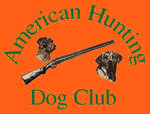The Club has developed a comprehensive testing and evaluation system. It is composed of a series of four tests,
which are administered at different stages of a dog's development. Dogs are judged against a standard, not against
each other.
The Hunting Instincts Test is for dogs under 16 months of age. This test evaluates the dog's potential for becoming
a finished gun dog before any concentrated training has taken place. Dogs are judged on nose, search, training,
point/flushing, retrieving, desire, and cooperation.
The Apprentice Hunting Dog Test is for dogs under 30 months of age. This test is usually administered after completion
of basic training and at the beginning of field training. Dogs are judged on nose, desire, cooperation, obedience,
search, pointing/flushing, steadiness on game, retrieval of shot birds, retrieval by drag, duck retrieve, heeling,
calmness under fire, and remaining where left.
The Trained Hunting Dog Test has no age limit. Each dog must pass this test twice to qualify for the title. Dogs are
judged on heeling off lead, calmness, remaining, search, double water retrieve (marked and blind), duck search,
pointing/flushing, double land retrieve (marked and blind), blind retrieve of crippled bird, nose, desire, cooperation,
and obedience.
The Master Hunting Dog Test is administered only to dogs with the THD title. This test of the completely finished
hunting dog requires running with a brace mate of the same sex. The dog is judged for hunting compatibility,
honoring point/flush, honoring land retrieve, flush on command, multiple land retrieves, search far shore for cripple,
call of game, work from boat or canoe, and honoring water retrieve.
Dogs are scored using a ten point system. The dogs must score six points, or better, in each category to qualify.
Failure in any category results in overall failure until the next testing period. The scoring represents a consensus
of opinion of three judges. All test results are kept for future reference. The tests are based on, and represent as
realistically as possible, situations which are routinely encountered during most hunting seasons. Passing the test,
as in real life, is dependent upon proper actions of both the handler and the dog. It is a team effort.

